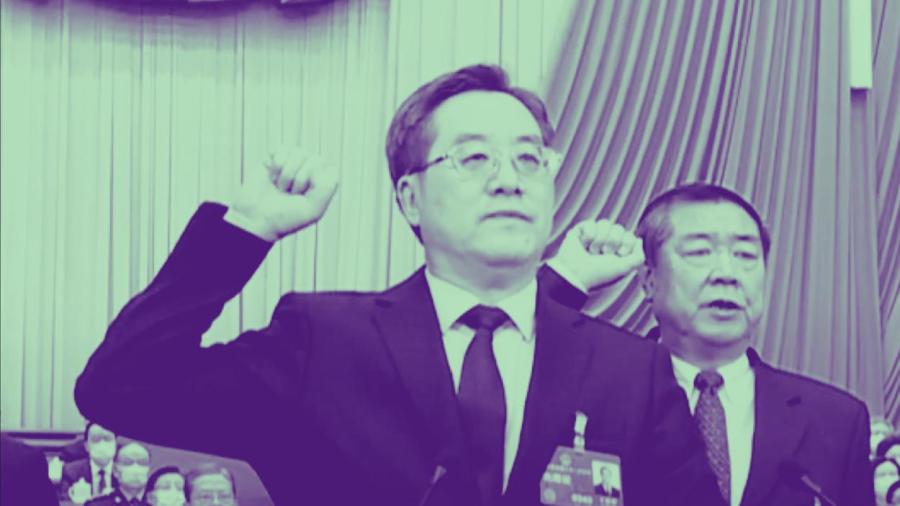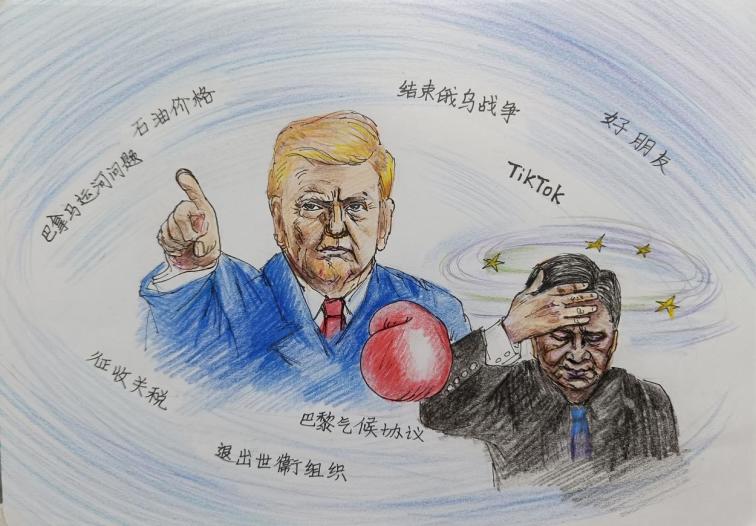Ding Xuexiang, Member of the CCP Politburo Standing Committee and Vice Premier of the State Council. (Video screenshot)
[People News] As Li Qiang travelled to Brazil to attend the BRICS meeting and Xi Jinping also departed Beijing for Shanxi, several other members of the Communist Party of China's Politburo Standing Committee have left Beijing for local research activities. For instance, Zhao Leji, the head of the National People's Congress, conducted research in Qinghai from July 6 to 8; Wang Huning, the head of the National Committee of the Chinese People's Political Consultative Conference, visited Hotan, Xinjiang, from July 7 to 9 to participate in a meeting regarding aid to Xinjiang; and from July 7 to 9, Ding Xuexiang, the top-ranking Vice Premier of the State Council, conducted research in Heilongjiang and Jilin.
With so many members of the Politburo Standing Committee leaving Beijing almost simultaneously, the question arises: Who is left to manage affairs in Beijing? It is clearly not Cai Qi and Li Xi, who have not announced any travel plans. This situation further indicates that the real control over the political landscape in Beijing is no longer held by the current few Standing Committee members.
Additionally, in the aforementioned report by state media, I came across an interesting photo. The report on Ding Xuexiang's research in Heilongjiang and Jilin featured two photos, and this is the second one, taken during his visit to CRRC Changchun Railway Vehicles Co., Ltd. Unlike previous images, this one has a distinctly familiar quality.
The photo captures a moment of Ding Xuexiang walking during his visit. In the image, Ding Xuexiang is stepping forward with his right foot, swinging his left arm ahead, leading a group of over ten people, while simultaneously tilting his head to listen to the introduction from the head of the CRRC company. The focal point of the entire photo is Ding Xuexiang, who is positioned centrally, exuding a unique sense of authority through his gestures and movements.
In the author's view, such compositions and postures have been most commonly seen in reports and images related to Xi Jinping's visits and research over the past five years, with other Standing Committee members rarely depicted in similar ways. To confirm this observation, the author specifically examined reports of research activities conducted by Ding Xuexiang and several other Standing Committee members over the past few years.
Over the past year, Ding Xuexiang has conducted research in various locations 12 times. Analysing the photos published in these reports, there is not a single image of Ding Xuexiang that shows him 'stepping forward'; instead, most images feature others surrounding him, either listening to introductions or engaging in discussions. Similarly, the publicly released research photos of other Standing Committee members, including Li Qiang, Zhao Leji, Wang Huning, and Cai Qi, do not exhibit such compositions. This is clearly not a mere 'coincidence' but rather a calculated arrangement. What could be the reason behind this?
Given the clear signs of Xi losing power, the question of who will succeed him—whether it will be one individual or a trio—has become a significant focus of public interest. Recently, there were reports from abroad suggesting that Ding Xuexiang was poised to ascend to a higher position, as he is among several candidates.
However, in December of last year, Mr. Jiang Wangzheng, who has previously made sensational claims while living in Australia, revealed once again that Ding Xuexiang would suspend all work starting December 20, 2024, with He Lifeng taking over Ding's routine responsibilities at the State Council. He later confirmed in another post that 'Ding Xuexiang has indeed ceased his duties; on today's document processing list at the State Council, there are no requests for Ding to review documents from the National Development and Reform Commission, Ministry of Education, or Ministry of Science and Technology. The National Development and Reform Commission has been assigned to He Lifeng, while Education and Science have been handed over to Liu Guozhong.' This suggests that Ding Xuexiang is in a troubling position.
However, during the State Council swearing-in ceremony on December 23, CCTV notably provided Ding Xuexiang with two camera shots, a privilege not extended to other vice premiers and state councillors. This has been interpreted as a public effort to 'debunk' rumours. In February of this year, Ding was again absent from the Artificial Intelligence Action Summit held in Paris, France. Just when speculation arose about his potential troubles, a few months later, Ding Xuexiang appeared to have safely navigated the situation, making several high-profile public appearances.
So, could Ding Xuexiang, who lacks local governance experience, ascend to a top position? Some analysts argue that this would not align with the unspoken rules of the Communist Party of China (CPC), but it is not entirely out of the question. If he has the backing of CPC elders, this possibility cannot be dismissed.
Having served as the chief secretary of the Shanghai Municipal Committee under three leaders—Xi Jinping, Yu Zhengsheng, and Han Zheng—Ding Xuexiang is not a close confidant of Xi. However, being adept in the intricacies of CPC politics, it is only natural for him to adjust his loyalties according to the prevailing circumstances. His recent downplaying of his role as the head of the leading group for promoting the Belt and Road Initiative may serve as evidence of this shift. It is worth noting that the Belt and Road Initiative was proposed and vigorously championed by Xi, who regards it as a significant 'achievement'.
While the meaning behind this unusual photo of Ding Xuexiang remains unclear, one thing is certain: such changes must have underlying reasons. How long will it take for the mystery to be unveiled? △
(First published by the People News)











News magazine bootstrap themes!
I like this themes, fast loading and look profesional
Thank you Carlos!
You're welcome!
Please support me with give positive rating!
Yes Sure!